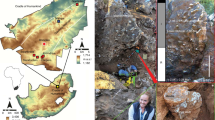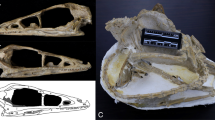Abstract
Previous research in Chad at the Toros-Menalla 266 fossiliferous locality (about 7 million years old) uncovered a nearly complete cranium (TM 266-01-60-1), three mandibular fragments and several isolated teeth attributed to Sahelanthropus tchadensis1,2,3. Of this material, the cranium is especially important for testing hypotheses about the systematics and behavioural characteristics of this species, but is partly distorted from fracturing, displacement and plastic deformation. Here we present a detailed virtual reconstruction of the TM 266 cranium that corrects these distortions. The reconstruction confirms that S. tchadensis is a hominid and is not more closely related to the African great apes4,5. Analysis of the basicranium further indicates that S. tchadensis might have been an upright biped, suggesting that bipedalism was present in the earliest known hominids, and probably arose soon after the divergence of the chimpanzee and human lineages.
This is a preview of subscription content, access via your institution
Access options
Subscribe to this journal
Receive 51 print issues and online access
$199.00 per year
only $3.90 per issue
Buy this article
- Purchase on Springer Link
- Instant access to full article PDF
Prices may be subject to local taxes which are calculated during checkout




Similar content being viewed by others
References
Brunet, M. et al. A new hominid from the Upper Miocene of Chad, Central Africa. Nature 418, 145–151 (2002)
Brunet, M. et al. New material of the earliest hominid from the Upper Miocene of Chad. Nature doi:10.1038/nature03392 (this issue)
Vignaud, P. et al. Geology and palaeontology of the Upper Miocene Toros-Menalla hominid locality, Chad. Nature 418, 152–155 (2002)
Wolpoff, M. H., Senut, B., Pickford, M. & Hawks, J. Sahelanthropus or ‘Sahelpithecus’? Nature 419, 581–582 (2002)
Brunet, M. et al. Sahelanthropus or ‘Sahelpithecus’? (Reply). Nature 419, 582 (2002)
White, T. Early hominids—diversity or distortion? Science 299, 1994–1997 (2003)
McCarthy, R. C. & Lieberman, D. E. Posterior maxillary (PM) plane and anterior cranial architecture in primates. Anat. Rec. 264, 247–260 (2001)
Enlow, D. H. Facial Growth (Saunders, Philadelphia, 1990)
Rohlf, F. J. & Slice, D. Extensions of the Procrustes method for the optimal superimposition of landmarks. Syst. Zool. 39, 40–59 (1990)
Zollikofer, C. P. E. & Ponce de León, M. S. Visualizing patterns of craniofacial shape variation in Homo sapiens . Proc. R. Soc. Lond. B 269, 801–807 (2002)
Penin, X., Berge, C. & Baylac, M. Ontogenetic study of the skull in modern humans and the common chimpanzees: neotenic hypothesis reconsidered with a tridimensional Procrustes analysis. Am. J. Phys. Anthropol. 118, 50–62 (2002)
Aiello, L. & Dean, C. An Introduction to Human Evolutionary Anatomy (Academic, London, 1990)
Kimbel, W. H., Johanson, D. & Rak, Y. The Skull of Australopithecus afarensis (Oxford Univ. Press, New York, 2004)
Wood, B. & Richmond, B. G. Human evolution: taxonomy and paleobiology. J. Anat. 196, 19–60 (2000)
Haile-Selassie, Y. Late Miocene hominids from the Middle Awash, Ethiopia. Nature 412, 178–181 (2001)
Pickford, M., Senut, B., Gommery, D. & Treil, J. Bipedalism in Orrorin tugenensis revealed by its femora. C. R. Palevol. 1, 191–203 (2002)
Strait, D. S. & Ross, C. F. Kinematic data on primate head and neck posture: implications for the evolution of basicranial flexion and an evaluation of registration planes used in paleoanthropology. Am. J. Phys. Anthropol. 108, 205–222 (1999)
Graf, W., de Waele, C. & Vidal, P. P. Functional anatomy of the head–neck movement system of quadrupedal and bipedal mammals. J. Anat. 186, 55–74 (1995)
Lieberman, D. E., Ross, C. F. & Ravosa, M. J. The primate cranial base: ontogeny, function, and integration. Yb. Phys. Anthropol. 43, 117–169 (2000)
Holloway, R. L., Broadfield, D. C., Yuan, M. S., Schwartz, J. H. & Tattersall, I. The Human Fossil Record Vol. 4: Brain Endocasts (Wiley, New York, 2004)
Kimbel, W. H., White, T. D. & Johanson, D. C. Cranial morphology of Australopithecus afarensis: a comparative study based on a composite reconstruction of the adult skull. Am. J. Phys. Anthropol. 64, 337–388 (1984)
Gonzalez, R. C. & Woods, R. E. Digital Image Processing (Prentice Hall, Upper Saddle River, New Jersey, 2002)
Zollikofer, C. P. E., Ponce de León, M. S. & Martin, R. D. Computer-assisted paleoanthropology. Evol. Anthropol. 6, 41–54 (1998)
Ponce de León, M. S. & Zollikofer, C. P. E. New evidence from Le Moustier. 1: Computer-assisted reconstruction and morphometry of the skull. Anat. Rec. 254, 474–489 (1999)
Delattre, A. & Fenart, R. L'hominisation du Crâne Étudiée par la Méthode Vestibulaire (CNRS, Paris, 1960)
Zollikofer, C. P. E., Ponce de León, M. S., Martin, R. D. & Stucki, P. Neanderthal computer skulls. Nature 375, 283–285 (1995)
Acknowledgements
We thank the Chadian Authorities (Ministère de l'Éducation Nationale de l'Enseignement Supérieur et de la Recherche, Université de N'Djaména, Centre National d'Appui à la Recherche au Tchad), the Ministère Français de l'Éducation Nationale (Faculté des Sciences, Université de Poitiers), Ministère de la Recherche (CNRS: Départment SDV & ECLIPSE), Ministère des Affaires Étrangères (DCSUR Commission des fouilles, Paris, et SCAC Ambassade de France à N'Djaména), the Revealing Hominid Origins Initiative (co-principal investigators F. C. Howell and T. D. White), the American School of Prehistoric Research, Harvard University, and the Swiss National Science Foundation, for support; the MultiMedia Laboratorium, University of Zürich (P. Stucki); EMPA Dübendorf, Switzerland, for industrial computed tomography (A. Flisch); all the MPFT members; and S. Riffaut, X. Valentin, G. Florent and C. Noël for technical support and administrative guidance.
Author information
Authors and Affiliations
Corresponding author
Ethics declarations
Competing interests
The authors declare that they have no competing financial interests.
Supplementary information
Supplementary Table S1
Craniometric measurements of the virtual reconstruction of the TM 266-01-60-1 Sahelanthropus tchadensis cranium. (XLS 12 kb)
Rights and permissions
About this article
Cite this article
Zollikofer, C., Ponce de León, M., Lieberman, D. et al. Virtual cranial reconstruction of Sahelanthropus tchadensis. Nature 434, 755–759 (2005). https://doi.org/10.1038/nature03397
Received:
Accepted:
Issue Date:
DOI: https://doi.org/10.1038/nature03397
This article is cited by
-
A century of exercise physiology: concepts that ignited the study of human thermoregulation. Part 4: evolution, thermal adaptation and unsupported theories of thermoregulation
European Journal of Applied Physiology (2024)
-
Applications of Microct Imaging to Archaeobotanical Research
Journal of Archaeological Method and Theory (2023)
-
Astronomically controlled aridity in the Sahara since at least 11 million years ago
Nature Geoscience (2022)
-
Postcranial evidence of late Miocene hominin bipedalism in Chad
Nature (2022)
-
Standing up for the earliest bipedal hominins
Nature (2022)
Comments
By submitting a comment you agree to abide by our Terms and Community Guidelines. If you find something abusive or that does not comply with our terms or guidelines please flag it as inappropriate.



